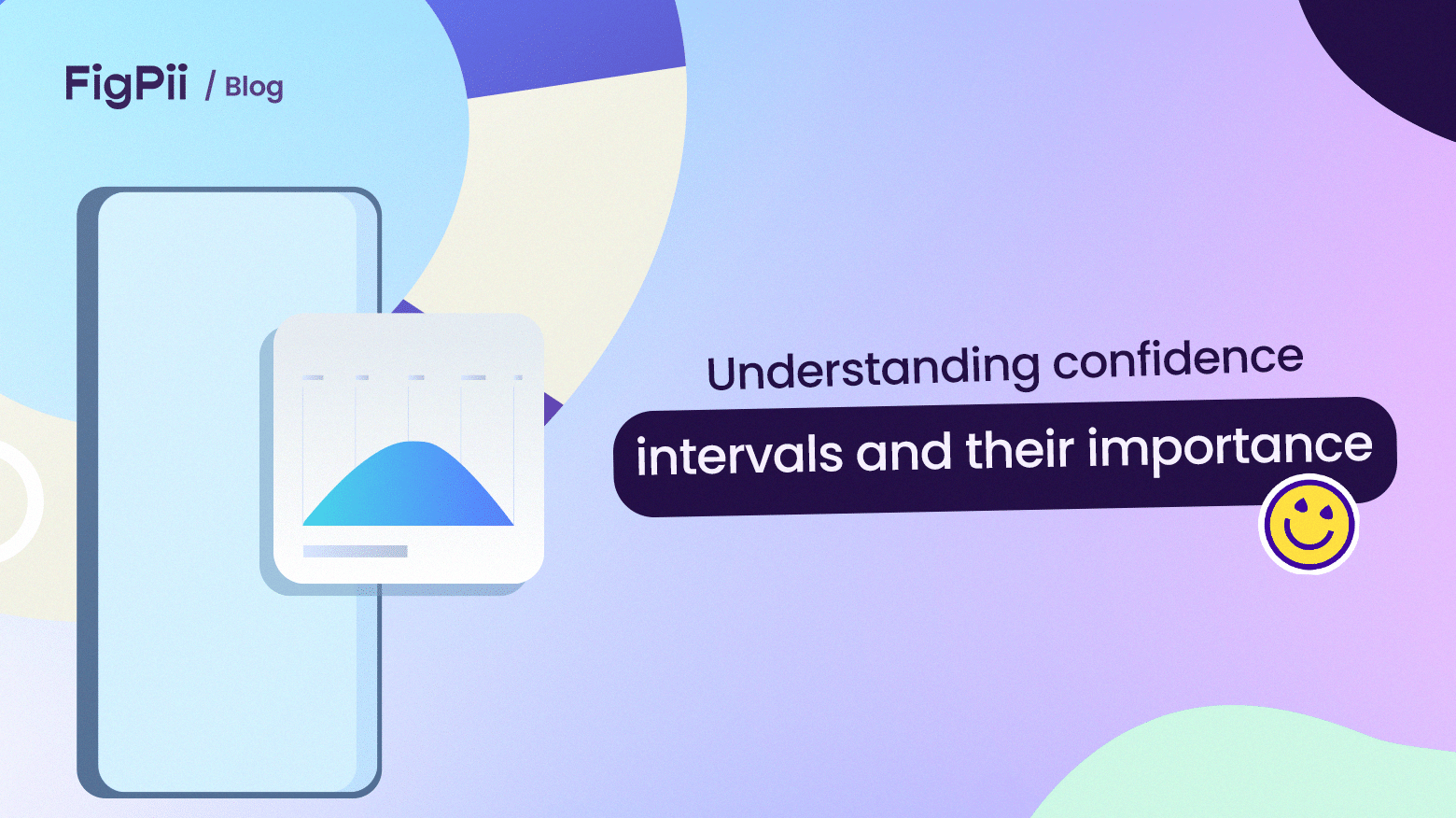Confidence intervals, often abbreviated as CIs, are essential statistical tools used to quantify the uncertainty associated with a sample statistic, such as a mean or proportion, and provide a range within which the true population parameter will likely fall.
In simpler terms, they offer a degree of certainty about the reliability of an estimate derived from a sample of data.
In practical terms, a confidence interval consists of two main components: a point estimate, which represents the sample statistic calculated from your data (e.g., the average conversion rate of visitors to a website), and a margin of error that defines a range around this estimate.
Here’s a breakdown of the key elements of a confidence interval:
- Point Estimate: This is the calculated value you’re interested in estimating, such as the mean or proportion. For instance, if you want to know the average time visitors spend on your website, the point estimate would be the average based on the data collected.
- Margin of Error: The margin of error (MOE) is a measure of the uncertainty or variability in your estimate. The margin of error is like a safety net for your estimate. It measures how much your best guess (the point estimate) might be off by. The wider the confidence interval, the greater the uncertainty.
For instance, if you estimate that the average time visitors spend on your website is 60 seconds and your MOE is ±5 seconds with 95% confidence, you’re pretty sure that the actual average time falls between 55 and 65 seconds.
The bigger the MOE, the less confident you are about the exact number. So, smaller MOEs mean more precise estimates.
In Conversion Rate Optimization and A/B testing context, confidence intervals provide critical insights into the reliability of test results, helping you make https://www.figpii.com/blog/how-to-do-ab-testing/informed decisions about website changes and the impact of those changes on user behavior.
The Significance of Confidence Intervals in CRO (A/B Testing)
Confidence intervals are the unsung heroes of A/B testing within Conversion Rate Optimization (CRO). They play a pivotal role in decision-making and help optimize resource allocation, mitigate the risk of false positives and negatives, and ensure the validity of results.
-
Optimization of Resource Allocation
In digital marketing, allocating resources wisely is paramount. Confidence intervals guide this allocation by indicating which variations in A/B testing are statistically significant. This prevents wasted time and resources on changes that don’t yield meaningful improvements.
-
Mitigation of False Positives/Negatives
Without confidence intervals, it’s easy to jump to conclusions prematurely. These intervals act as reality checks, helping you avoid false positives (thinking changes work when they don’t) and false negatives (thinking changes don’t work when they do). They provide a balanced perspective on the impact of changes.
-
Avoidance of Premature Decisions
Impulsivity can be the enemy of data-driven decision-making. Confidence intervals promote a more systematic approach. They encourage patience by illustrating the level of uncertainty in your A/B test results. Instead of hastily implementing changes that may or may not work, you can make informed decisions based on a solid understanding of the data.
-
Quantifying Uncertainty
Confidence intervals tell a story beyond the point estimate. They provide a range within which the true effect of changes is likely to lie. This quantification of uncertainty helps you understand the potential variability in outcomes and make decisions considering this uncertainty.
-
Confidence in Results Validity
Confidence intervals reassure you that your A/B test results are not just a product of random chance. When you see a significant difference between two variations, backed by a tight confidence interval, you can be confident that the observed effect is genuine and not a statistical fluke.
How do confidence intervals help in interpreting A/B testing results?
Interpreting A/B testing results is like deciphering a message from your website’s visitors. You’re seeking to understand whether the changes you’ve made (the variant B) have significantly improved compared to the original (the control A).
This interpretation is where confidence intervals shine, as they act as your decoding key, providing insights into the meaning and reliability of your test results.
-
Quantifying the Magnitude of Change
Confidence intervals allow you to assess whether there’s a difference between the control and variant groups and the magnitude of that difference.
In other words, they tell you how big or small the impact of your changes is likely to be. A narrow confidence interval suggests a precise estimate, indicating a substantial effect, while a wider interval signifies greater uncertainty and potentially a smaller effect.
-
Distinguishing Significance from Noise
A common pitfall in A/B testing is mistaking random noise for a meaningful improvement. Without confidence intervals, you might see a slightly higher conversion rate in the variant and immediately conclude that it’s better.
However, confidence intervals help you discern whether this difference is statistically significant or just a random fluctuation.
-
Avoiding Premature Celebrations (or Panic)
Sometimes, when early results in A/B testing appear favorable, there’s a rush to celebrate. Conversely, there might be panic if things don’t look great initially. Confidence intervals advocate for a more level-headed approach.
They indicate how certain or uncertain you should be about the observed difference. Even if you see a lift in conversions, if the confidence interval is wide, it suggests you should exercise caution before making conclusions.
-
Understanding Statistical Significance
The term “statistical significance” means that the observed difference between control and variant groups is unlikely to be due to random chance.
Confidence intervals provide a direct way to understand this significance. It strongly indicates statistical significance if the confidence interval doesn’t overlap with zero (for positive effects) or excludes certain thresholds (e.g., a target conversion rate increase).
-
Communicating Results Effectively
A/B testing is rarely done in isolation; results are often communicated to stakeholders or team members.
Confidence intervals offer a clear and concise way to convey the reliability of your findings. You can confidently say, “We saw a 5% increase in conversions, with a 95% confidence interval of ±2%, which indicates a statistically significant improvement.”
What are the pitfalls of not using confidence intervals in A/B Testing
-
Missed Opportunities for Iteration
A/B testing is often an iterative process. Confidence intervals help in assessing the impact of changes accurately. Without them, you might miss opportunities to refine and enhance your website gradually, resulting in missed conversion rate improvements over time.
-
Loss of Credibility
When A/B test results are communicated to stakeholders or clients, the absence of confidence intervals can lead to credibility issues. Decision-makers may question the validity of results, and trust in the optimization process can erode.
-
Ineffective Resource Allocation
Deciding where to allocate resources, such as development time or marketing budget, becomes easier with confidence intervals. Resources may be directed towards changes that lack statistical significance instead of focusing on improvements that could have a more substantial impact.
-
Failure to Identify Valuable Changes
A/B testing is about identifying changes that genuinely improve user engagement or conversion rates. Without confidence intervals, there’s a risk of overlooking valuable modifications. Some changes might have a genuine impact but go unnoticed due to a lack of statistical rigor.
-
Risky Decision-Making
The absence of confidence intervals can lead to impulsive decisions. Marketers or CROs might implement changes based on initial positive results, only to realize later that these changes had no significant impact, resulting in wasted time and effort.
-
Misinterpretation of Noise as Signals
Without confidence intervals, A/B test results may be subject to misinterpretation. Small fluctuations in data can be mistaken for meaningful improvements or declines, leading to incorrect conclusions and potentially wasted resources on unwarranted changes.
How to Calculate Confidence Intervals
The formula for calculating confidence intervals is:
(CI) = x̄± Z(S ÷ √n)
Where:
- CI: Confidence Interval, the range within which the true population parameter is likely to fall.
- X̄: Sample Mean, the average value calculated from your sample data.
- Z: Z-Score, a critical value from the standard normal distribution, which corresponds to your chosen confidence level.
- S: Sample Standard Deviation, a measure of how spread out your data is.
- n: Sample Size, the number of data points in your sample.
Confidence Level and Significance Level in Confidence Intervals
When calculating confidence intervals, the significance level (often denoted as α) and the confidence level are important concepts to note.
- Significance Level (α): This is the probability of making a Type I error, which is the chance of wrongly concluding that there is a significant difference when there isn’t one. Standard significance levels are 0.05 (5%) and 0.01 (1%).
- Confidence Level: The confidence level (often denoted as 1 – α) is the complement of the significance level. It represents the probability that the calculated confidence interval contains the true population parameter.
For example, a 95% confidence level implies that you are 95% confident that the true parameter falls within the calculated interval.
To calculate a confidence interval, you’ll need to choose your desired confidence level (e.g., 95% or 99%), find the corresponding Z-score from a standard normal distribution table, calculate your sample mean and standard deviation, and determine your sample size.
Then, you can plug these values into the formula to compute the confidence interval.
How to calculate confidence intervals
Calculating confidence intervals step by step is a practical process that involves several key stages. Let’s walk through each step with an example to illustrate the process.
-
Step 1: Data Collection
Begin by collecting your data. In our example, let’s say you’re interested in estimating the average time (in minutes) users spend on your website per session. You collect a random sample of 50 sessions and record the time spent.
-
Step 2: Choosing a Confidence Level
Next, decide on your desired confidence level. We’ll use a standard confidence level of 95% for this example.
-
Step 3: Calculate the Sample Mean (x̄)
Calculate the mean (average) of your sample data. Let’s assume that the sample mean (x̄) is 8.5 minutes.
-
Step 4: Determine the Standard Deviation
Calculate the standard deviation of your sample data. Let’s assume our example’s standard deviation (S) is 1.2 minutes.
-
Step 5: Find the Standard Error
Standard error (SE) measures how much your sample mean might vary from the true population mean. Calculate it using the formula:
SE = S / √n Where:
- S is the standard deviation (1.2 minutes in our case).
- n is the sample size (50 sessions).
- So, SE = 1.2 / √50 ≈ 0.1696 minutes.
-
Step 6: Calculate the Z-Score (or T-Score)
Determine the Z-score from a standard normal distribution table. For a 95% confidence level, the Z-score is approximately 1.96.
-
Step 7: Calculate the Margin of Error
Calculate the margin of error (MOE) using the formula:
MOE = Z × SE
In our example, MOE = 1.96 × 0.1696 ≈ 0.3324 minutes.
-
Step 8: Calculate the Lower and Upper Bounds
Now, compute the lower and upper bounds of your confidence interval:
Lower Bound = x̄ – MOE
Upper Bound = x̄ + MOE
For our example:
Lower Bound = 8.5 – 0.3324 ≈ 8.1676 minutes
Upper Bound = 8.5 + 0.3324 ≈ 8.8324 minutes
-
Step 9: Apply Results in the CI Formula
You now have your lower and upper bounds. The confidence interval is the range between these two values:
CI = (8.1676 minutes, 8.8324 minutes)
This means you are 95% confident that the average time users spend on your website per session falls within this interval.
Interpreting Confidence Intervals
Interpreting confidence intervals (CIs) is crucial for making informed decisions based on data. Let’s explore how to interpret CIs, including the lower and upper bounds, what it means when a CI includes the null hypothesis, and how to draw conclusions from CI results.
Lower Bound: The lower bound of a CI represents the lowest plausible value for the parameter you’re estimating. In our previous example of website session times, the lower bound of the CI (e.g., 8.1676 minutes) suggests that you can be 95% confident that the true average session time is at least this long but may be longer.
Upper Bound: Conversely, the upper bound represents the highest plausible value for the parameter. In our example, the upper bound (e.g., 8.8324 minutes) indicates that you can be 95% confident that the true average session time is at most this long but could be shorter.
When a CI includes the Null Hypothesis
When a CI includes the null hypothesis value, it implies that the observed effect is not statistically significant. In other words, there is a high probability that the true parameter lies within the interval, including the possibility of no effect.
In our website example, if the null hypothesis stated that the average session time is 8 minutes, and your 95% CI ranged from 8.1676 to 8.8324 minutes, it would include the null hypothesis value, suggesting no statistically significant difference.
Drawing Conclusions from CI results
Interpreting CIs involves comparing them to predefined thresholds or hypotheses:
Statistical Significance: A CI that does not include a predefined threshold (e.g., zero or a null hypothesis value) suggests statistical significance. For example, if the 95% CI for your A/B test’s conversion rate increase does not include the null hypothesis value, it indicates a significant improvement.
Practical Significance: Even if a CI is statistically significant, you should also consider practical significance. Does the observed effect, though statistically real, matter in practice? If a 1% conversion rate increase in your A/B test is statistically significant but won’t significantly impact your business, it might not be practically significant.
Decision-Making: You can make informed decisions based on the CI results and their interpretation. If a CI for a website change’s impact on user engagement does not include the null hypothesis value and is practically significant, it might justify implementing that change.
Challenges associated with confidence intervals
-
Sample Size Limitations
Imagine you’re conducting an A/B test on a new website feature. One of the first challenges you might encounter is having a relatively small sample size. A small sample size can result in wide CIs, making it harder to draw precise conclusions.
It’s like trying to estimate the average height of people in a city by measuring just a handful of residents – your estimate won’t be very accurate. You might need to collect more data or extend the testing period to address this challenge.
-
Multiple Testing
In A/B testing, it’s common to run multiple experiments simultaneously. However, when you do this, you face a challenge called multiple testing. It’s like conducting several experiments at once – the more tests you run, the higher the chance of finding a statistically significant result by random chance alone.
This can lead to false positives. You may need to adjust your confidence level or use statistical methods designed for multiple comparisons to combat this challenge.
-
Extended Duration of Testing
Imagine you’re running an A/B test on a seasonal product, like ice cream. You need to consider the challenge of testing duration. If you run the test during a slow ice cream season, your CIs might not accurately represent how the product performs during the summer peak.
It’s like assessing the popularity of winter coats in July – the results won’t be representative. To overcome this challenge, you might need to run tests for an entire seasonal cycle or account for seasonal variations in your analysis.
-
Seasonal Variations
Speaking of seasons, seasonal variations can pose another challenge. Think of it as trying to determine the average temperature in a city throughout the year. You’ll miss the seasonal patterns if you only look at a month.
In A/B testing, ignoring seasonal variations can lead to misleading CIs. To address this, you’d need to analyze data across different seasons or segment your analysis by season.
-
Segmentation Complexity
Imagine you’re a large e-commerce platform offering a wide range of products. The challenge here is segmentation complexity. Different products may perform differently, and creating CIs when running a/b tests for each product category can be challenging.
It’s akin to analyzing the performance of every type of vehicle in a car dealership – it’s a lot of work. To tackle this, you might need to prioritize segments or use advanced statistical methods to handle the complexity.
-
Interpretation Complexity
Lastly, interpreting CIs can be complex. Let’s say your A/B test results produce overlapping CIs for two variants. It’s not immediately clear who’s the winner. To make informed decisions, consider other factors, like practical significance or user feedback.
Conclusion
Confidence intervals are a critical tool in A/B testing because they provide a clear and reliable measure of the precision of your results.
Incorporating them into your analysis ensures a more robust and trustworthy decision-making process during your A/B testing process.



